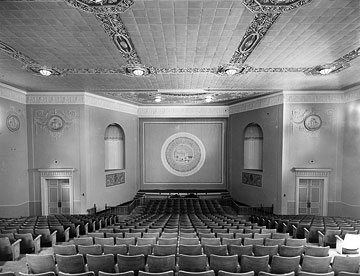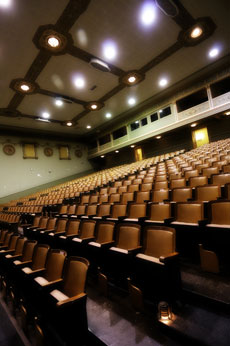Lincoln Hall Project
The Many Faces of Lincoln Hall
“The Little Theater”
James White, supervising architect on the original structure, designed the 1929 addition that doubled its size. Following calls for more centrally located classroom space, he added a large lecture hall that also served as a theater.

The Department of Psychology wanted the hall to serve as a laboratory instead of a theater, and then-President David Kinley was sympathetic, but White pointed out that a laboratory would have only narrow usage. In the end White (and an enthusiastic theater community) won out, and the final result was called one of the “best-equipped little theaters” of its time.
The “Little Theater” had stage lights and a slightly curved cyclorama extending from the back of the stage, serving as a light reflector and sounding board. The ceiling was made of perforated metal blocks to absorb sound, and the walls were decorated with Adamesque panels, niches, and medallions.
The theater’s first production, Beggar on Horseback, by the Illini Theater Guild, was performed in March 1930. Productions continued until 1968, when the theater was rendered obsolete by the Krannert Center for the Performing Arts.
George Halas and the War Memorial
Placed between the two original wings of Lincoln Hall, the theater displaced an old courtyard that memorialized those affected by World War I. In 1968 a group from the classes of 1918 and 1919, including legendary alumnus and former Chicago Bears owner George Halas, began work to replace the lost memorial. In 1969 they dedicated “Memorial Court,” located in the breezeway between the theater and Lincoln Hall’s interior walls, to honor Illini who lost their lives in World War I.

A Thriving Theater Sees Decline
For almost four decades Lincoln Hall Theater bustled with activity. Several times a year student and faculty groups put on productions such as She Stoops to Conquer (performed there in 1934), Twelfth Night (1944), A Streetcar Named Desire (1956), The Crucible (1962), and many others.
Performers had complaints about the theater, however, including the lack of showers. A dispute arose between the Illini Theater Guild and the Physical Plant Department in 1936, after the guild, exasperated that no showers had been added to the facility, informally paid a custodian extra to remove discarded body makeup after a production of A Midsummer Night’s Dream.